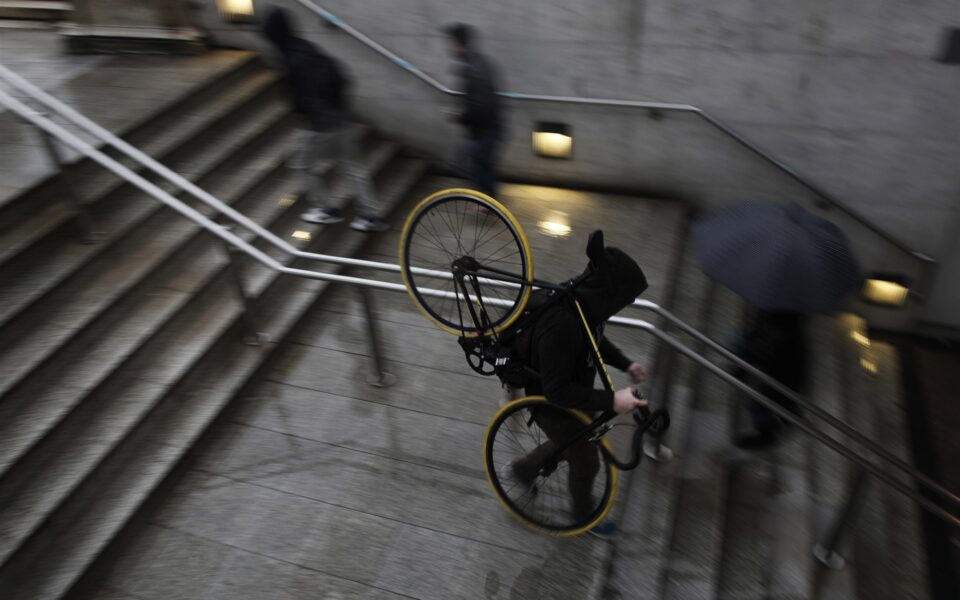Can Athens become a city of bicycles?
Experts weigh into the discussion on what is needed to wean the Greek capital off eco-harmful motorized transport

In today’s world, with the coronavirus pandemic having boosted the use of bicycles and the climate crisis making it imperative to cut emissions from energy-intensive motorized transport, countries across the globe are redesigning their cities with cycling and walking at the forefront.
But not Greece – and certainly not Athens.
“Bicycle traffic in all Greek cities except a few, like Trikala and Larissa, is very, very low, because on the one hand there is no infrastructure for cyclists and on the other hand there are not enough cyclists for infrastructure,” says George Yannis, a professor in traffic and safety engineering and director of the Department of Transportation Planning and Engineering at the National Technical University of Athens (NTUA). “So we are in an early and hybrid stages of development.”
Athens, unlike many other European capitals, lags in terms of infrastructure, but also in mentality and education.
Asked where we stand in relation to Europe on the issue of cycling, Panayotis Tournikiotis, a professor of theory of architecture at the NTUA, sets the scene: “Far, far away…,” he says.
However, experts speaking to Kathimerini agreed that this can be reversed. What is needed is the political willpower and a change of mindset.
How do bicycles get around in Athens?
According to Greece’s Traffic Code, cyclists use bicycle lanes where they exist and, where they don’t, are required to use the right-hand lane of the street on all roads, except on highways and expressways, where they are prohibited.
“The only prohibition is on highways like Kifissos and Attiki Odos. On the rest of the network they circulate normally, like motorcycles and scooters,” Yannis explains.
“We like to say that the only roads on which bicycles are banned are those with a first and last name because there are so few of them,” said Panagiotis Pitsilos, president of the Greek Federation of urban cycling.
Are bicycles a burden on the city’s traffic system?
Experts say no. On the contrary, they are the solution to the traffic problem.
“If anything is encumbering the city, it’s motorized traffic, not bicycles,” says Yannis.
“The motor vehicle burdens the city with exhaust fumes, congestion and accidents. We have to understand that the space taken up by a car with a single driver, even if they have a passenger or two, can easily be used by 10 bicycles. In other words, the ratio we gain in service is huge. As long as we change attitudes, of course.”
He explains that many metropolises around the world now leading by example in cycling, were also ignorant of its benefits not so long ago.
Are bicycles ‘invisible’?
‘On the one hand there is no infrastructure for cyclists and on the other hand there are not enough cyclists for infrastructure’
The argument that the bicycle accidents will increase if the number of cyclists increases, is debunked by the science, experts argue.
“International studies have shown that the larger the bicycle network and the more cyclists on the roads, the fewer accidents and serious incidents there are,” says Yannis.
The way drivers treat cyclists has also improved in recent years.
“When cycling first started becoming popular 10 or 15 years ago, it initially caused a backlash from drivers,” says Pitsilos. “But over time, with the increase in cyclists and the pandemic that put a lot of bicycles on the road, this attitude has started to change. Of course, there are still drivers who shout, honk and swear, thinking that when you’re out on a bicycle you’re just going for a ride and that there is no other reason to use it. But overall, things are better.”
So, can Athens become a bicycle-friendly city?
All three experts agree that Athens not only can, but is also the ideal city for cycling, due to its relatively good weather and, despite having seven hills, its geomorphology.
“Athens has certain specific characteristics: it is a big city, it is surrounded by mountains and it has hills,” Tournikiotis stresses. “But not all of the basin is hills and mountains; most of it is comparatively smooth, if not flat.”
“Athens is the ideal city for cycling,” adds Yannis. “We have such good weather, so many days of sunshine.”
Pitsilos also argues that Athens can become a bicycle-friendly city, but stresses that we need to look at the issue comprehensively.
“It is not just about cycling infrastructure; it is also about widening pavements, creating crossings, installing speed bumps, lowering speed limits, investing in education and informing people about the benefits of all this,” he says.
“The benefits are not just for cyclists, but for everyone. When there are fewer accidents will it be just for me? When there is less pollution from exhaust fumes, will it be just for me? When there is less noise pollution, will it be just for me? When there is inexpensive transportation, is it just for me?” he asks.
More bicycles means more leverage
The number of cyclists on the streets of Athens has risen significantly in recent years, putting pressure on municipal authorities and the central government to develop and implement more Sustainable Urban Mobility Plans (SUMPs).
But have any steps actually been taken?
Some local governments have made leaps, like in Larissa, central Greece, which the experts describe as a shining example.
In the Greek capital, certain suburbs, like Vrilissia and Kifissia in the north, have developed decent bicycle networks. Agioi Anargyroi, also in the north, has a bicycle path too, while Glyfada on the southern coast is planning one.
“But it is very, very tentative; there seems to be a lack of resolution,” says Pitsilos. “I think [municipal authorities] are afraid of the possible backlash from motorists and others, like shopkeepers. Greeks are accustomed to taking their cars to the bakery down the street,” says Pitsilos.
Tournikiotis points to a plan that was drawn up in 2014 at the behest of the country’s municipal authorities.
“Many such studies exist and are dormant. But they could be brought up to date now that so much is changing. The question is whether the state is willing to give up space on major thoroughfares, to take a lane away from cars and give it to bicycles, but also within the neighborhoods, to create routes so that longer journeys can be made safely,” he says.
“Politicians follow the collective will. At the moment, collectively, there is no will to put aside our cars in favor of bicycles,” he concludes.





